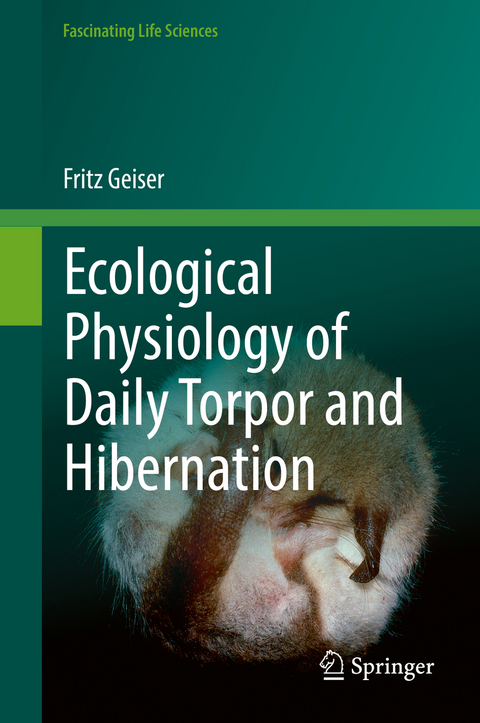
Ecological Physiology of Daily Torpor and Hibernation
Springer International Publishing (Verlag)
978-3-030-75524-9 (ISBN)
This book provides an in-depth overview on the functional ecology of daily torpor and hibernation in endothermic mammals and birds. The reader is well introduced to the physiology and thermal energetics of endothermy and underlying different types of torpor. Furthermore, evolution of endothermy as well as reproduction and survival strategies of heterothermic animals in a changing environment are discussed.
Endothermic mammals and birds can use internal heat production fueled by ingested food to maintain a high body temperature. As food in the wild is not always available, many birds and mammals periodically abandon energetically costly homeothermic thermoregulation and enter an energy-conserving state of torpor, which is the topic of this book. Daily torpor and hibernation (multiday torpor) in these heterothermic endotherms are the most effective means for energy conservation available to endotherms and are characterized by pronounced temporal and controlled reductions in bodytemperature, energy expenditure, water loss, and other physiological functions. Hibernators express multiday torpor predominately throughout winter, which substantially enhances winter survival. In contrast, daily heterotherms use daily torpor lasting for several hours usually during the rest phase, some throughout the year. Although torpor is still widely considered to be a specific adaptation of a few cold-climate species, it is used by many animals from all climate zones, including the tropics, and is highly diverse with about 25-50% of all mammals, but fewer birds, estimated to use it. While energy conservation during adverse conditions is an important function of torpor, it is also employed to permit or facilitate energy-demanding processes such as reproduction and growth, especially when food supply is limited. Even migrating birds enter torpor to conserve energy for the next stage of migration, whereas bats may use it to deal with heat. Even though many heterothermic species will be challenged by anthropogenic influences such as habitat destruction, introduced species, novel pathogens and specifically global warming, not all are likely to be affected in the same way. In fact it appears that opportunistic heterotherms because of their highly flexible energy requirements, ability to limit foraging and reduce the risk of predation, and often pronounced longevity, may be better equipped to deal with anthropogenic challenges than homeotherms. In contrast strongly seasonal hibernators, especially those restricted to mountain tops, and those that have to deal with new diseases that are difficult to combat at low body temperatures, are likely to be adversely affected.
This book addresses researchers and advanced students in Zoology, Ecology and Veterinary Sciences.
lt;p>Fritz Geiser grew up in a small rural village near Heidelberg, Germany. He was fascinated by animals from early in life and studied Biology at the University of Hohenheim, Stuttgart. He travelled to Australia after his undergraduate degree on a DAAD scholarship to work at CSIRO at the Macquarie University in Sydney. He received a PhD from the Flinders University in Adelaide, Australia, held a Humboldt Fellowship at the University of Washington in Seattle, USA, and a post-doctoral position the University of Adelaide. He has worked in Zoology at the University of New England, Armidale, Australia, since 1988, but during this time has conducted projects in Argentina (Patagonia), Austria, Canada, China, Germany, South Africa and the USA. He is interested in comparative and environmental physiology of animals and most of his work concerns ecological physiology of birds and mammals especially with regard to hibernation and daily torpor. He has published over 260 papers on these and related topics and has was awarded a Madgwick Distinguished Professorship at University of New England and a Discovery Outstanding Researcher Award from the Australian Research Council.
Chapter 1. Introduction, Background and Definitions.- Chapter 2. Quantifying Torpor.- Chapter 3. Diversity and Geography of Torpor and Heterothermy.- Chapter 4. Patterns and Expression of Torpor.- Chapter 5. Physiology and Thermal Biology.- Chapter 6. Seasonality of Daily Torpor and Hibernation.- Chapter 7. Ecological and Behavioural Aspects of Torpor.- Chapter 8. Torpor during Reproduction and Development.- Chapter 9. Dietary Lipids, Thermoregulation and Torpor Expression.- Chapter 10. Evolution of Endothermy and Torpor.- Chapter 11. Concluding Remarks.
| Erscheinungsdatum | 25.08.2021 |
|---|---|
| Reihe/Serie | Fascinating Life Sciences |
| Zusatzinfo | XVII, 317 p. 116 illus., 55 illus. in color. |
| Verlagsort | Cham |
| Sprache | englisch |
| Maße | 155 x 235 mm |
| Gewicht | 685 g |
| Themenwelt | Naturwissenschaften ► Biologie ► Ökologie / Naturschutz |
| Naturwissenschaften ► Biologie ► Zoologie | |
| Veterinärmedizin | |
| Schlagworte | animal energy metabolism • Body Temperature Regulation • daily torpor • endothermy • heterothermic animals • hibernating birds • Hibernation • multiday torpor • Torpor • torpor patterns • torpor physiology |
| ISBN-10 | 3-030-75524-X / 303075524X |
| ISBN-13 | 978-3-030-75524-9 / 9783030755249 |
| Zustand | Neuware |
| Haben Sie eine Frage zum Produkt? |
aus dem Bereich


